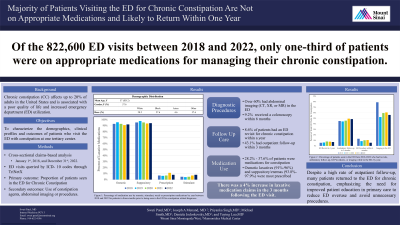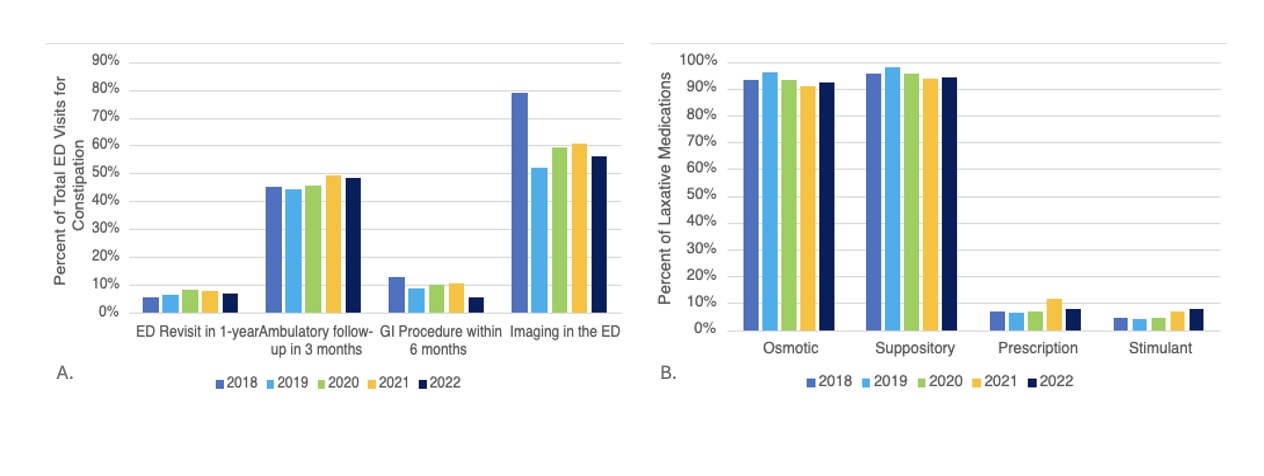Monday Poster Session
Category: Functional Bowel Disease
P2343 - Majority of Patients Visiting the Emergency Department for Chronic Constipation Are Not on Appropriate Medications and Likely to Return Within One Year
Monday, October 28, 2024
10:30 AM - 4:00 PM ET
Location: Exhibit Hall E

Has Audio
.jpg)
Swati Patel, MD
Mount Sinai Morningside/West, Icahn School of Medicine at Mount Sinai
New York, NY
Presenting Author(s)
Swati Patel, MD1, Joseph Menand, MD1, Priyanka Singh, MD1, Michael S.. Smith, MD, MBA2, Daniela Jodorkovsky, MD3, Yuying Luo, MD3
1Mount Sinai West, Icahn School of Medicine at Mount Sinai, New York, NY; 2Icahn School of Medicine at Mount Sinai, New York, NY; 3Mount Sinai Center for Gastrointestinal Physiology & Motility, New York, NY
Introduction: Chronic constipation (CC) affects up to 20% of adults in the United States and is associated with a poor quality of life and increased emergency department (ED) utilization. We aim to characterize the demographics, clinical profiles and outcomes of patients with constipation who seek emergency care at one tertiary center.
Methods: This was a cross-sectional claims-based analysis utilizing a de-identified database (TriNetX). We queried all ED visits with ICD-10 codes associated with constipation between January 1st, 2018, and December 31st, 2022. Primary outcome was the proportion of patients seen in the emergency department for CC. Secondary outcomes included demographics, proportion of patients receiving various constipation agents, abdominal imaging or procedures. Database counts were rounded up to the nearest 10th digit by default.
Results: Approximately 0.85% (ranging from 0.80-0.88%) of the 822,600 ED visits between 2018 and 2022 were associated with at least one constipation-related diagnosis. Overall, the cohort had a mean age of 57.0 (SD = 22), 57.6% female and racially diverse (28.2% White, 27.6% Black, 37.6% other, 4.6% Asian). Approximately one-third of patients (ranging from 28.2%-37.6%) were on medications for constipation in the 3-months prior to their index ED visit; most patients used osmotic laxatives (91%-96%) and/or suppository/enemas (93.8%- 97.9%), and a minority of patients used stimulant (4.2%-7.8%) or prescription agents for constipation (6.3%-11.4%; see Figure 1). There was an 8.6% rate for ED revisit for chronic constipation within one year for the entire cohort, while 43.1% were seen in the outpatient office within 3-months. Over 60% of patients had abdominal imaging (CT, XR or MR) while in the ED, and 9.2% received a colonoscopy within 6-months (see Table 2). In the 3 months following the ED visit, there was a 4% increase in laxative medication claims for the entire cohort.
Discussion: Only one-third of patients visiting the ED for constipation at one center were on appropriate medications for their constipation in the 3-months prior to their ED visit and less than 8% were on prescription agents. This may contribute to the overuse of ED resources for constipation-related visits, including procedures and imaging. Future efforts on managing constipation and assessing severity should be targeted towards patient-education in the primary care setting.

Disclosures:
Swati Patel, MD1, Joseph Menand, MD1, Priyanka Singh, MD1, Michael S.. Smith, MD, MBA2, Daniela Jodorkovsky, MD3, Yuying Luo, MD3. P2343 - Majority of Patients Visiting the Emergency Department for Chronic Constipation Are Not on Appropriate Medications and Likely to Return Within One Year, ACG 2024 Annual Scientific Meeting Abstracts. Philadelphia, PA: American College of Gastroenterology.
1Mount Sinai West, Icahn School of Medicine at Mount Sinai, New York, NY; 2Icahn School of Medicine at Mount Sinai, New York, NY; 3Mount Sinai Center for Gastrointestinal Physiology & Motility, New York, NY
Introduction: Chronic constipation (CC) affects up to 20% of adults in the United States and is associated with a poor quality of life and increased emergency department (ED) utilization. We aim to characterize the demographics, clinical profiles and outcomes of patients with constipation who seek emergency care at one tertiary center.
Methods: This was a cross-sectional claims-based analysis utilizing a de-identified database (TriNetX). We queried all ED visits with ICD-10 codes associated with constipation between January 1st, 2018, and December 31st, 2022. Primary outcome was the proportion of patients seen in the emergency department for CC. Secondary outcomes included demographics, proportion of patients receiving various constipation agents, abdominal imaging or procedures. Database counts were rounded up to the nearest 10th digit by default.
Results: Approximately 0.85% (ranging from 0.80-0.88%) of the 822,600 ED visits between 2018 and 2022 were associated with at least one constipation-related diagnosis. Overall, the cohort had a mean age of 57.0 (SD = 22), 57.6% female and racially diverse (28.2% White, 27.6% Black, 37.6% other, 4.6% Asian). Approximately one-third of patients (ranging from 28.2%-37.6%) were on medications for constipation in the 3-months prior to their index ED visit; most patients used osmotic laxatives (91%-96%) and/or suppository/enemas (93.8%- 97.9%), and a minority of patients used stimulant (4.2%-7.8%) or prescription agents for constipation (6.3%-11.4%; see Figure 1). There was an 8.6% rate for ED revisit for chronic constipation within one year for the entire cohort, while 43.1% were seen in the outpatient office within 3-months. Over 60% of patients had abdominal imaging (CT, XR or MR) while in the ED, and 9.2% received a colonoscopy within 6-months (see Table 2). In the 3 months following the ED visit, there was a 4% increase in laxative medication claims for the entire cohort.
Discussion: Only one-third of patients visiting the ED for constipation at one center were on appropriate medications for their constipation in the 3-months prior to their ED visit and less than 8% were on prescription agents. This may contribute to the overuse of ED resources for constipation-related visits, including procedures and imaging. Future efforts on managing constipation and assessing severity should be targeted towards patient-education in the primary care setting.

Figure: Figure 1: A. Percentage of patients seen in the ED from 2018-2022 who had revisits, ambulatory follow-up, GI Procedures, or imaging while in the ED, by year. B. Percentage of medication use by osmotic, stimulant, rectal or prescription medications by year between 2018 and 2022 for patients in three-months prior to being seen in the ED for constipation related diagnoses.
Disclosures:
Swati Patel indicated no relevant financial relationships.
Joseph Menand indicated no relevant financial relationships.
Priyanka Singh indicated no relevant financial relationships.
Michael Smith: Castle Biosciences – Advisory Committee/Board Member, Consultant. CDx Diagnostics – Consultant. Lucid Diagnostics – Advisory Committee/Board Member, Consultant. Provation Medical – Consultant. Steris Endoscopy – Advisory Committee/Board Member, Consultant.
Daniela Jodorkovsky: Atmo Biosciences – Consultant.
Yuying Luo indicated no relevant financial relationships.
Swati Patel, MD1, Joseph Menand, MD1, Priyanka Singh, MD1, Michael S.. Smith, MD, MBA2, Daniela Jodorkovsky, MD3, Yuying Luo, MD3. P2343 - Majority of Patients Visiting the Emergency Department for Chronic Constipation Are Not on Appropriate Medications and Likely to Return Within One Year, ACG 2024 Annual Scientific Meeting Abstracts. Philadelphia, PA: American College of Gastroenterology.
